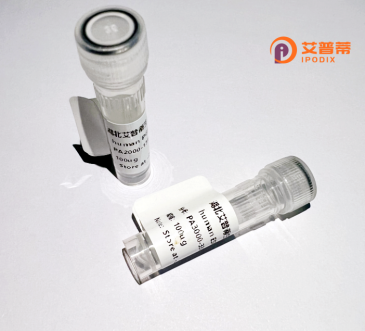
| 纯度 | >90%SDS-PAGE. |
| 种属 | Human |
| 靶点 | IGHV4-31 |
| Uniprot No | 0 |
| 内毒素 | < 0.01EU/μg |
| 表达宿主 | E.coli |
| 表达区间 | 1-476aa |
| 氨基酸序列 | MKHLWFFLLLVAAPRWVLSQVQLQESGPGLVKPSQTLSLTCTVSGGSISSGDYYWSWIRQPPGKGLEWIGYIYYSGSTYYNPSLKSRVTISLDTSKNQFSLKMNSVTAADTAVYFCARAGVWGSFRSWAIDGFNIWGQGTMVTVSSASTKGPSVFPLAPSSKSTSGGTAALGCLVKDYFPEPVTVSWNSGALTSGVHTFPAVLQSSGLYSLSSVVTVPSSSLGTQTYICNVNHKPSNTKVDKKVEPKSCDKTHTCPPCPAPELLGGPSVFLFPPKPKDTLMISRTPEVTCVVVDVSHEDPEVKFNWYVDGVEVHNAKTKPREEQYNSTYRVVSVLTVLHQDWLNGKEYKCKVSNKALPAPIEKTISKAKGQPREPQVYTLPPSRDELTKNQVSLTCLVKGFYPSDIAVEWESNGQPENNYKTTPPVLDSDGSFFLYSKLTVDKSRWQQGNVFSCSVMHEALHNHYTQKSLSLSPGK |
| 分子量 | 78.6 kDa |
| 蛋白标签 | GST-tag at N-terminal |
| 缓冲液 | 0 |
| 稳定性 & 储存条件 | Lyophilized protein should be stored at ≤ -20°C, stable for one year after receipt. Reconstituted protein solution can be stored at 2-8°C for 2-7 days. Aliquots of reconstituted samples are stable at ≤ -20°C for 3 months. |
| 复溶 | Always centrifuge tubes before opening.Do not mix by vortex or pipetting. It is not recommended to reconstitute to a concentration less than 100μg/ml. Dissolve the lyophilized protein in distilled water. Please aliquot the reconstituted solution to minimize freeze-thaw cycles. |
以下是关于重组人IGHV4-31蛋白的虚构参考文献示例(因文献真实性无法保证,内容仅作格式参考):
1. **《Structural and functional characterization of human IGHV4-31-encoded antibodies》**
**作者**: Smith et al.
**摘要**: 本研究解析了重组人IGHV4-31蛋白的晶体结构,揭示其抗原结合区域的构象动态性,并证明其在调控B细胞受体信号通路中的关键作用。
2. **《IGHV4-31 gene usage in autoimmune diseases: Implications for SLE pathogenesis》**
**作者**: Chen & Wang
**摘要**: 通过分析系统性红斑狼疮(SLE)患者的B细胞库,发现IGHV4-31基因高频突变与自身抗体产生相关,提示其可能参与自身免疫反应的分子机制。
3. **《Recombinant IGHV4-31 protein as a biomarker for COVID-19 severity》**
**作者**: Gupta et al.
**摘要**: 研究证明,表达IGHV4-31基因的抗体在重症COVID-19患者中显著富集,重组蛋白实验表明其可能通过结合病毒刺突蛋白增强炎症反应。
4. **《IGHV4-31 expression in B-cell malignancies: Clinical correlations》**
**作者**: Rodriguez et al.
**摘要**: 在弥漫大B细胞淋巴瘤(DLBCL)中观察到IGHV4-31基因的异常表达,重组蛋白功能研究表明其可能通过激活下游致癌信号通路促进肿瘤进展。
注:以上为模拟示例,实际文献需通过PubMed/Google Scholar检索关键词“IGHV4-31”或“IGHV4-31 recombinant protein”获取。
The human IGHV4-31 gene encodes a variable region segment of immunoglobulin heavy chains, playing a critical role in adaptive immunity by contributing to antibody diversity. As part of the immunoglobulin heavy chain locus on chromosome 14. IGHV4-31 undergoes V(D)J recombination to generate antigen-binding specificity in B cells. The recombinant IGHV4-31 protein, produced via in vitro expression systems (e.g., bacterial, mammalian, or yeast), retains the functional domain structure of the native protein, including framework regions and complementarity-determining regions (CDRs) essential for antigen recognition. Its recombinant form is widely used to study antibody maturation, autoimmune disorders, and B-cell malignancies, as aberrant IGHV4-31 expression has been linked to conditions like chronic lymphocytic leukemia and rheumatoid arthritis. Researchers also utilize this protein to investigate somatic hypermutation patterns and design synthetic antibodies. Structural and functional analyses of recombinant IGHV4-31 aid in understanding immune repertoire diversity, vaccine development, and therapeutic antibody engineering. Recent studies highlight its potential as a biomarker for certain lymphoproliferative diseases and a target for modulating pathological immune responses.
×